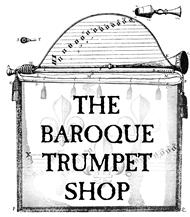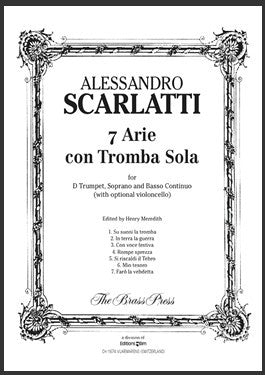Alessandro Scarlatti - 7 Arie for Trumpet, Soprano, and Continuo
$ 42.90
SCARLATTI Alessandro, 7 Arie - complete
trumpet, soprano voice and basso continuo
Composer: Scarlatti, Alessandro (1660-1725)
Level: intermediate
Genre: baroque
Arranger/Editor: Henry Meredith
Publisher The Brass Press
Details
1. Si suoni la tromba
One of the most difficult arias in the set, this piece employs a prominent extra-harmonic note (the e"-sharp in the cadence of measure 40 - achieved on the natural trumpet by "bending" the tenth partial) and a wider range of rhythmic and ornamental figures than the others. The juxtaposition of triplet, dotted, and equal sixteenth-note patterns suggests a lilting (2:1 ratio) inequality (see Donington, 1973, 255-271, which includes examples by Scarlatti showing similar usage). A vigorous inequality (dotted figures in strict time) might also be effective in "opposition" to the triplets, considering the "battle" topic of the poem. The presence of the trumpet leaves no doubt that the aria suitably expresses the text. The opening triadic «trumpet call» motive was clearly derived from ascending figures of genuine military signals (compare with the «Prima chiamata di Guerra» and «Seconda chiamata, che va sonata avanti la Battaglia» found in Fantini, pp. 12 and 14) and might easily inspire the soldiers to victory. After all, ascending fourths were often employed to depict fierceness and daring, as melodic intervals were frequently linked to particular «passions» in accordance with the Doctrine of Affections, which seemed to effect much of the music of the period. The «resounding» is portrayed musically by the shorter, echoing figures in the B section.
2. In terra la guerra
Though avoiding any specific reference to the political turmoil in Italy during Scarlatti's time, man's perennial search for peace is poignantly expressed in this aria. The «putting to flight» of war is depicted clearly in the rapidly ascending scale figures to which the words «fugace» and «voli» are set.
The opening trumpet signal could be derived from a genuine battle call (compare with Mersenne's «La Charge» and Fantini's «Battaglia»), and perhaps the trumpet is declaring war on war. The B section provides a charming contrast in its smooth and «peaceful» stepwise melody.
3. Con voce festiva
This lively «giga» portrays the festivity and rejoicing of the text. The tempo and wide leaps of this uncharacteristic trumpet part placed a great demand for accuracy on the baroque trumpeter. Prominent intervals of ascending thirds, fourths, and fifths, and major thirds moving in both directions certainly corroborate seventeenth-century theorists' ideas on appropriate intervals for expressing specific «affections» – in this case gaiety, liveliness, joyousness, and energy. Word-painting occurs for «eco» and «risponda», and the trumpet's exclamatory reply to the off-beat «gioisca» of the voice is effective writing.
4. Rompe sprezza
This shortest of the seven arias in the set opens with a "broken" melodic statement accompanied by detached chords signifying the shattered ego of the rejected suitor. Thematic development, an important aspect of Scarlatti's compositional process, is evident in the different functions he puts to the paired sixteenth-note motive.
5. Si riscaldi il Tebro
The murmuring undulation of the billows of the Tiber river is clearly depicted in the rolling motion of the melody at the words «l'onda» and «mormorar». Of the seven arias, this one most exploits the echo technique to display the coloratura skills of the vocalist, which must in turn be matched by the trumpeter's brilliant virtuosity. Opportunities for imitation arise frequently out of the text («mormorar, risponda, sussurar») and the composer took full advantage of them.
6. Mio tesoro
The only aria of the set to possess a descriptive title, this piece represents a French dance which was introduced perhaps by Lully in the middle of the 17th century and eventually superseded the older dance forms of the suite to become a standard movement (minuet with trio) in the classical symphony. Scarlatti himself contributed to this development by closing many of his opera sinfonias with a minuet.
The trumpet part is unusually graceful and elegant as it states the principal melody at the beginning and end of the first section. The entry of the voice turns part of the opening motive downward into a «longing» sigh (see last three beats of bar 13), and spins out fragmented thematic variants throughout the vocal portion of the A section. Measures 19-22, with their syncopated sobbing, and ascending crescendo of intensity, along with the ascending figures in 27-28 and 32-33, reflect the love pangs and rising hopes of the serenader.
7. Faro la vendetta
The opening statement of this aria has a strong resemblance to that of No. 5. Less obvious in its musical portrayal of the text than some of the other arias in the set, «Farò fa vendetta» nevertheless sets an overall mood of resoluteness spurred by jealous anger. The motivically active bass line provides for three equal parts which could be construed to represent the romantic triangle disclosed in the last line of the text.
Henry Meredith


Share this item: